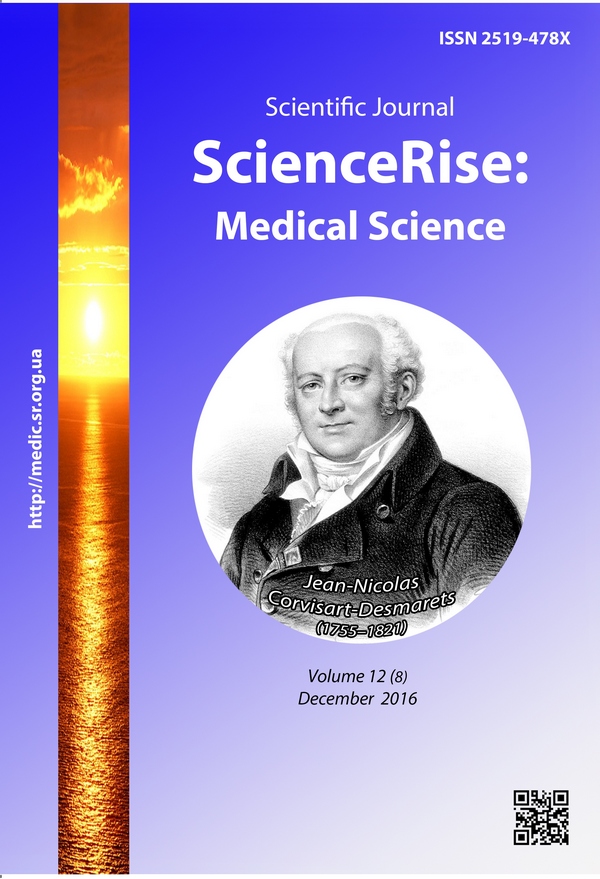Нейростимуляційний контроль блокад медіальних гілочок задніх гілок спинномозкових нервів у лікуванні больового “фасет-синдрому” поперекового спондилоартрозу та плануванні денервації дуговідросткових суглобів
DOI:
https://doi.org/10.15587/2519-4798.2016.85422Ключові слова:
больовий фасет-синдром, нейростимуляція, медіальні гілочки задніх гілок спинномозкових нервівАнотація
У статті обговорюється проблема лікувально- діагностичних блокад у разі больового “фасет-синдрому” поперекового спондилоартрозу та плануванні денервації дуговідросткових суглобів. Наведено досвід ефективності виконання блокад медіальних гілочок задніх гілок спинномозкових (МГ ЗГ СМН) нервів під контролем нейростимуляції у 96 пацієнтiв, протягом 3, 6 та 12 місяців. Встановлено переваги даного методу і рекомендації до широкого застосування
Посилання
- Binder, D. S., Nampiaparampil, D. E. (2009). The provocative lumbar facet joint. Current Reviews in Musculoskeletal Medicine, 2 (1), 15–24. doi: 10.1007/s12178-008-9039-y
- Sirenko, A. A. (2011). Diagnostika, profilaktika i lecheni recidivov spondiloartralgii posle denervacii poyasnichnyh dugootrostchatyh sustavov. Kharkiv, 20.
- Radchenko, V., Kutsenko, V., Perfiliev, O., Popov, A. (2016). Neurotomy of the medial posterior branches of spinal nerves under endoscopic control in the treatment of lumbar syndrome spondyloarthralgiy. Orthopaedics, traumatology and prosthetics, 3, 16–21. doi: 10.15674/0030-59872016316-21
- Manchikanti, L., Pampati, V., Singh, V., Falco, F. J. (2013). Assessment of the escalating growth of facet joint interventions in the medicare population in the United States from 2000 to 2011. Pain Physician, 16 (4), E365–E378.
- Manchikanti, L., Kaye, A. D., Boswell, M. V., Bakshi, S., Gharibo, C. G., Grami, V., Grider, J. S. et. al. (2015). A systematic review and best evidence synthesis of the effec-tiveness of therapeutic facet joint interventions in managing chronic spinal pain. Pain Physician, 18 (4), E535–E582.
- Park, J. W., Cheon, M. W., Lee, M. H. (2016). Phantom Study of a New Laser-Etched Needle for Improving Visibility During Ultrasonography-Guided Lumbar Medial Branch Access With Novices. Annals of Rehabilitation Medicine, 40 (4), 575–582. doi: 10.5535/arm.2016.40.4.575
- Amrhein, T. J., Joshi, A. B., Kranz, P. G. (2016). Technique for CT Fluoroscopy–Guided Lumbar Medial Branch Blocks and Radiofrequency Ablation. American Journal of Roentgenology, 207 (3), 631–634. doi: 10.2214/ajr.15.15694
- Bogduk, N., Wilson, A. S., Tynan, W. T. (1982). The human lumbar dorsal rami. Journal of Anatomy, 134 (2), 383–397.
- Saito, T., Steinke, H., Miyaki, T., Nawa, S., Umemoto, K., Miyakawa, K. et. al. (2013). Analysis of the Posterior Ramus of the Lumbar Spinal Nerve. Anesthesiology, 118 (1), 88–94. doi: 10.1097/aln.0b013e318272f40a
- Cohen, S. P., Raja, S. N. (2007). Pathogenesis, Diagnosis, and Treatment of Lumbar Zygapophysial (Facet) Joint Pain. Anesthesiology, 106 (3), 591–614. doi: 10.1097/00000542-200703000-00024
- Rocha, I., Cristante, A., Marcon, R., Oliveira, R., Letaif, O., Barros Filho, T. (2014). Controlled medial branch anesthetic block in the diagnosis of chronic lumbar facet joint pain: the value of a three-month follow-up. Clinics, 69 (8), 529–534. doi: 10.6061/clinics/2014(08)05
- Cohen, S. P., Moon, J. Y., Brummett, C. M., White, R. L., Larkin, T. M. (2015). Medial Branch Blocks or Intra-Articular Injections as a Prognostic Tool Before Lumbar Facet Radiofrequency Denervation. Regional Anesthesia and Pain Medicine, 40 (4), 376–383. doi: 10.1097/aap.0000000000000229
- Radchenko, V., Perfiliev, O., Larichev, V. (2016). The peculiarities of location of medial twigs of posterior branches of spinal nerves (topographic-anatomical studies). Orthopaedics, traumatology and prosthetics, 1, 78–83. doi: 10.15674/0030-59872016178-83
- Cohen, S. P., Williams, K. A., Kurihara, C., Nguyen, C., Shields, C., Kim, P. et. al. (2010). Multicenter, Randomized, Comparative Cost-effectiveness Study Comparing 0, 1, and 2 Diagnostic Medial Branch (Facet Joint Nerve) Block Treatment Paradigms before Lumbar Facet Radiofrequency Denervation. Anesthesiology, 113 (2), 395–405. doi:10.1097/aln.0b013e3181e33ae5
- Van Zundert, J., Mekhail, N., Vanelderen, P., van Kleef, M. (2010). Diagnostic Medial Branch Blocks before Lumbar Radiofrequency Zygapophysial (Facet) Joint Denervation. Anesthesiology, 113 (2), 276–278. doi: 10.1097/aln.0b013e3181e33b02
##submission.downloads##
Опубліковано
Як цитувати
Номер
Розділ
Ліцензія
Авторське право (c) 2016 Олександр Вячеславович Перфільєв

Ця робота ліцензується відповідно до Creative Commons Attribution 4.0 International License.
Наше видання використовує положення про авторські права Creative Commons CC BY для журналів відкритого доступу.
Автори, які публікуються у цьому журналі, погоджуються з наступними умовами:
1. Автори залишають за собою право на авторство своєї роботи та передають журналу право першої публікації цієї роботи на умовах ліцензії Creative Commons CC BY, котра дозволяє іншим особам вільно розповсюджувати опубліковану роботу з обов'язковим посиланням на авторів оригінальної роботи та першу публікацію роботи у цьому журналі.
2. Автори мають право укладати самостійні додаткові угоди щодо неексклюзивного розповсюдження роботи у тому вигляді, в якому вона була опублікована цим журналом (наприклад, розміщувати роботу в електронному сховищі установи або публікувати у складі монографії), за умови збереження посилання на першу публікацію роботи у цьому журналі.










